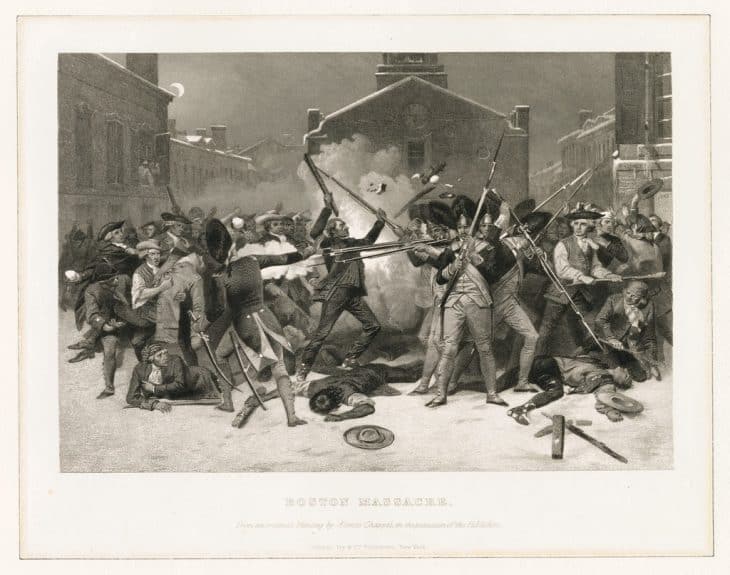
- Name: The Boston Massacre, the Bloody Massacre in King Street, the State Street Massacre
- Date: March 5, 1770
- Location: Boston, Massachusetts, British America
- Deaths: 5 people
- Injuries: 6 non-fatal injuries
- Assailants: British Army soldiers
- Victims: Boston civilians
- Trial date: November 27, 1770
- Causes: Conflict between a patriot mob and British soldiers, tension between British rulers and colonists
- Political Importance: Laying the foundations of the American Revolution
- Cause: The Boston Massacre Started as a Street Fight
- Background: There Were 4,000 British Troops among 20,000 Boston Residents
- Cause: The Tension Was Caused by Rising Taxes
- Victims: Half of Boston’s Population Attended the Victims’ Funerals
- Icon: One of the Victims Later Became an Anti-Slavery Icon
- Propaganda: The Boston Massacre Was Used as Propaganda by Both Sides
- Trial: Two British Soldiers Were Convicted of Manslaughter
- Debate: An Anonymous Pamphlet Was Created by the Colonists
- Debate: The Soldiers’ Side of the Story Was Told in a Pamphlet
- Artwork: The Incident Was Depicted in a Famous Engraving by Paul Revere
- The British Soldiers Were Defended by a Founding Father of the US
- The Trial of Captain Preston Was the First to Use the Basis of “Reasonable Doubt”
- Two British Soldiers Escaped the Death Penalty by Knowing How to Read
- The Boston Massacre Is Now Reenacted Every Year
- The Incident Started with an Unpaid Wig Bill
- There is a 25-foot Boston Massacre/Crispus Attucks Monument
- Samuel Adams, John Adams’ Cousin, Was Outspoken against British Rule
- Great Britain Repealed Most Taxes following Public Outrage
- The Boston Massacre Was Predicted by Benjamin Franklin in 1768
- Three African-Americans Testified on Behalf of the British Soldiers
Boston Massacre Facts Infographics
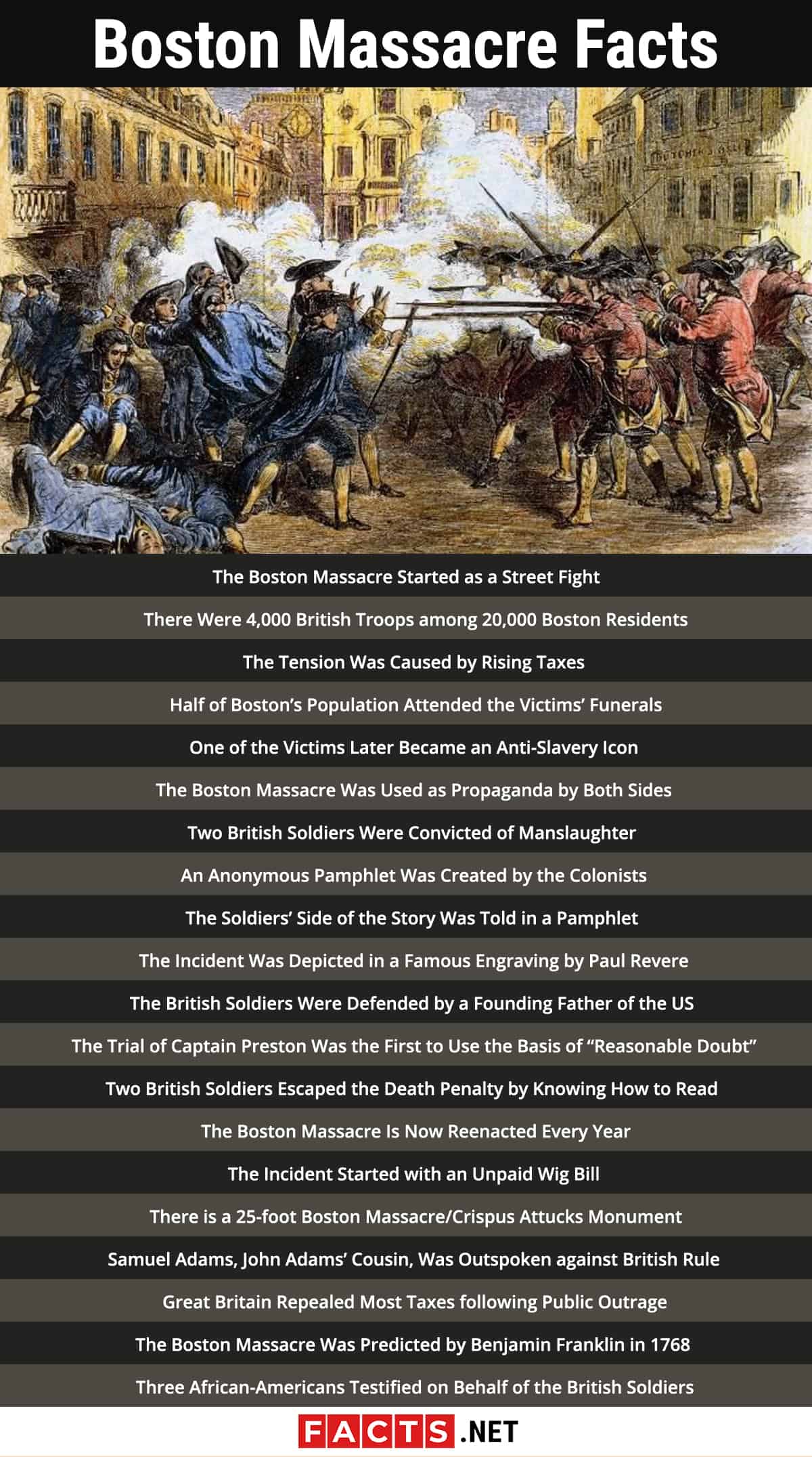
The Boston Massacre Started as a Street Fight
Many Boston Massacre facts mention the historical importance of the incident, but it actually started simply as a street fight. On March 5, 1770, a mob of “patriots” was riled up against a squad of British soldiers, who were standing guard in front of the Custom House building. When the mob started to throw snowballs, stones, and sticks, some of the British soldiers feared for their own safety and fired into the crowd. They killed and injured several people. The event was later on known as the Boston Massacre by the colonists and as the Incident on King Street by the British.
There Were 4,000 British Troops among 20,000 Boston Residents
There are many Boston Massacre facts concerning what happened after the incident, but first, let’s take a look at what happened before then. While the Boston Massacre helped push the colonists toward the patriotism movement, there were already tensions before the incident. British troops had been stationed in Boston since 1768. Before the Massacre, the number had soared to 4,000 troops. This is a significant number, especially considering the population of only 20,000 residents in Boston at the time. The tensions between the Boston residents and the British rulers deepened with the rising military presence.
The Tension Was Caused by Rising Taxes
The heavy military presence was necessitated by the rising tension in Boston following the Townshend Acts, which were passed in 1767. The Townshend Acts were a series of laws that initiated the rise of taxes on tea, paper, glass, lead and paint. The tax rise was intended to fund the salaries of governors and judges to ensure their loyalty to Great Britain. Naturally, the colonies opposed the tax raise on the grounds that it was a violation of their rights. Protests broke out in Boston and the British sent in troops to maintain order in their colonies. Clashes among the colonists and British soldiers happened on a regular basis before and after the Boston Massacre.
Half of Boston’s Population Attended the Victims’ Funerals
Many Boston Massacre facts focus on the victims, including the five that were killed and six that were injured. All victims were civilians who were part of the crowd. The five people who were killed were Crispus Attucks, Samuel Gray, Patrick Carr, Samuel Maverick and James Caldwell.
After the incident, these five victims were hailed as heroes. It’s estimated that 10,000 people, or half of Boston’s population at the time, attended their funerals. They were all buried in the Granary Burying Ground. This is where three signers of the Declaration of Independence – Samuel Adams, John Hancock, and Robert Treat Paine – would also be buried later.
One of the Victims Later Became an Anti-Slavery Icon
Of the five victims that were killed in the Boston Massacre, only one was non-Caucasian. Many studies on Boston Massacre facts have attempted to shed light on the life of Crispus Attucks. However, it is still not clear whether Attucks was a slave or a free man at the time of his death.
Despite the lack of information, Attucks later became an anti-slavery icon in the 18th century, representing the role of African-Americans in the American Revolution. At this time, artworks depicting the massacre started to show a black victim, whereas earlier artworks showed only Caucasian victims in the crowd.
The Boston Massacre Was Used as Propaganda by Both Sides
After the incident, both the British and the colonists told different stories from their own perspectives. Boston Massacre facts show that the incident was heavily used in both sides’ propaganda to defame the other side. The colonists took advantage of the incident to accuse British troops of cruelty and to fuel public outrage. In a famous engraving by Paul Revere, Captain Preston was portrayed as giving order to his men to fire into the crowd, even though there was no evidence of that happening. The Custom House was also labeled as the “Butcher’s Hall”.
Two British Soldiers Were Convicted of Manslaughter
After the incident, eight British soldiers and their captain Thomas Preston were immediately arrested. A trial was held to appease the public and to leave no ground for retaliation from the British. Captain Thomas Preston was trialed separately from his men and was found not guilty. Of the eight soldiers, six were released based on the lack of evidence. Two British soldiers, Hugh Montgomery and Matthew Killroy, were convicted of manslaughter. Many witnesses testified that they saw these two soldiers firing directly into the crowd.
As well as the soldiers, four civilians were also trialed after a witness claimed that they had fired shots from the Custom House. However, all of them were acquitted due to a lack of evidence.
An Anonymous Pamphlet Was Created by the Colonists
After the incident, Boston residents put together an anonymous pamphlet called A Short Narrative of the Horrid Massacre. As well as the Boston Massacre itself, the pamphlet also mentioned other incidents before that. All such incidents were described as unprovoked attacks on law-abiding citizens. This pamphlet garnered a great deal of attention and had a large influence on public debates. The pamphlet was not distributed locally, so as to avoid influencing the jury’s decision. However, it was widely available in London and also in other British colonies.
The Soldiers’ Side of the Story Was Told in a Pamphlet
Boston Massacre facts show that the British and the colonists engaged in a propaganda battle after the incident. Each side tried to have their version of the story heard. Governor Thomas Hutchinson, Massachusetts governor at the time, had collected testimonies from the British soldiers in order to create a pamphlet called A Fair Account of the Late Unhappy Disturbance in Boston.
The pamphlet blamed Boston residents for failing to honour parliamentary laws. Speaking of the incidents, the pamphlet accused the residents of intentionally ambushing and threatening the soldiers. However, the colonists’ pamphlet reached London earlier, and, therefore, Governor Hutchinson’s pamphlet did not attract as much attention as planned.
The Incident Was Depicted in a Famous Engraving by Paul Revere
The incident was first illustrated in a painting by a young Boston artist named Henry Pelham. Paul Revere, who later became one of the first signers of the Declaration of Independence, created an engraving based on this painting. To increase public outrage, Paul Revere altered some details. For example, Captain Preston can be seen giving the order to his men to shoot. The Custom Office is labeled Butcher’s Hall and a musket was shown shooting from one of its windows. Even though Paul Revere may not have been present at the scene, this engraving was later used as evidence in the trial to show the location of the bodies.
The British Soldiers Were Defended by a Founding Father of the US
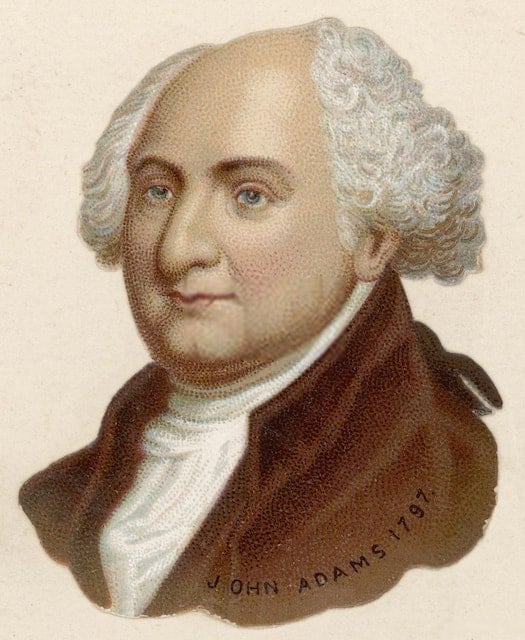
One of the surprising Boston Massacre facts reveals that John Adams, who later became the second US President, represented the British soldiers during their trial. John Adams joined the trial only after Captain Preston and his soldiers were turned down by several lawyers. While Adams at the time was not yet President, he was a leading Patriot. The reason Adams took the case was to uphold his strong belief that everyone deserved a fair trial. His argument in front of the jury was that the soldiers had the right to defend themselves. Because of his work, six of the soldiers who were initially accused of manslaughter were found not guilty.
The Trial of Captain Preston Was the First to Use the Basis of “Reasonable Doubt”
During the trial of Captain Thomas Preston, the testimony was contradictory and there were reasons to believe in his innocence. For example, in the engraving by Paul Revere, he was depicted giving the order to his men to shoot. This later on was proven impossible, as Captain Preston was also depicted standing in front of the firing line.
Many witnesses testified that they did not hear a shooting order from Preston. Plus, many witnesses relayed that the crowd was taunting the soldiers to shoot, shouting and chanting “Fire!” at the British soldiers. This could have led to the false assumption that the order came from Captain Preston. In the end, the jury acquitted Preston on the basis of “Reasonable Doubt”, marking the first time this phrase was used in court.
Two British Soldiers Escaped the Death Penalty by Knowing How to Read
Out of the eight British soldiers arrested, two were found guilty of manslaughter and could have faced the death penalty. One of the most interesting Boston Massacre facts is that these soldiers avoided the death sentence simply by reading from the Bible.
John Adams, their lawyer and, later on, the second US President, presented a loophole in English law called “benefit of the clergy”. This law stated that if a man could read, he could claim to be clergy and would then not be bound by secular law. The two British soldiers were then asked to read out loud from the Bible. Instead of the death sentence, they were only branded with a letter M on their thumbs, short for “manslaughter”. This was to prevent the same defence being used again in the future.
The Boston Massacre Is Now Reenacted Every Year
The Boston Massacre is now known as an important event in American history. Many saw this incident as the start of the American Revolution. Too many people, it is seen as a representation of patriotism. To commemorate the event, every year a reenactment is carried out. The reenactment is organised by the Boston Historical Society on March 5, the anniversary of the original event. The reenactment closely follows the facts as we know them now. It takes place on the exact spot of the Massacre – the intersection of State and Devonshire in downtown Boston, where the old Custom House used to stand.
The Incident Started with an Unpaid Wig Bill
The Boston Massacre held great historical importance later on, but the cause of it was quite trivial. The whole incident was triggered by arguments around an unpaid bill for a wig. On March 5, Edward Garrick, a wigmaker apprentice, called out to a British officer about a wig he had not paid for, while he had in fact had done so. Insults were exchanged between Garrick and other British soldiers until one of them struck him. The tension escalated quickly and became what we now know as the Boston Massacre. The event would have been nothing but a minor conflict, if not for the already strong tension between Bostonians and the British.
There is a 25-foot Boston Massacre/Crispus Attucks Monument
In 1887, the Massachusetts General Court decided to build a monument to commemorate the Boston Massacre. The monument is 25 feet high and 10 feet wide. The monument depicts a figure representing the Spirit of the Revolution, with a broken chain in one hand and the American flag in the other. The crown of the British monarchy is crushed under the figure’s foot. At the top of the column are the names of the five Boston Massacre victims. A relief of the event is shown at the base.
Samuel Adams, John Adams’ Cousin, Was Outspoken against British Rule
Boston Massacre facts show that the opposition to British occupation had started well before the incident. Much of this sentiment was spurred on by Samuel Adams, a cousin to John Adams. He was one of the leading organisers of protests over the Sugar Act and the Stamp Act. His criticism of such policies helped stir up public unrest in the period leading up to the Massacre.
Despite his sentiment toward British occupation, Samuel Adams actually convinced his cousin John Adams to defend the soldiers. He wanted to give the soldiers fair trials and prove that Bostonians were more than a lawless mob. After the trial, however, he did condemn the trial outcome in a series of essays, arguing that the soldiers should have been convicted.
Great Britain Repealed Most Taxes following Public Outrage
Boston Massacre facts show that after the incident, public outrage spread quickly throughout Boston and many other colonial regions, thanks to newspapers, pamphlets and other propaganda. To appease the colonies, Great Britain decided to repeal almost all of the new taxes. The tea tax was the only tax left to show that British authority still remained. This did help relieve some of the tension in the colonies as many merchants lifted the bans on British goods. Many patriot leaders, however, saw this only as a temporary solution and were still unsatisfied with British occupation.
The Boston Massacre Was Predicted by Benjamin Franklin in 1768
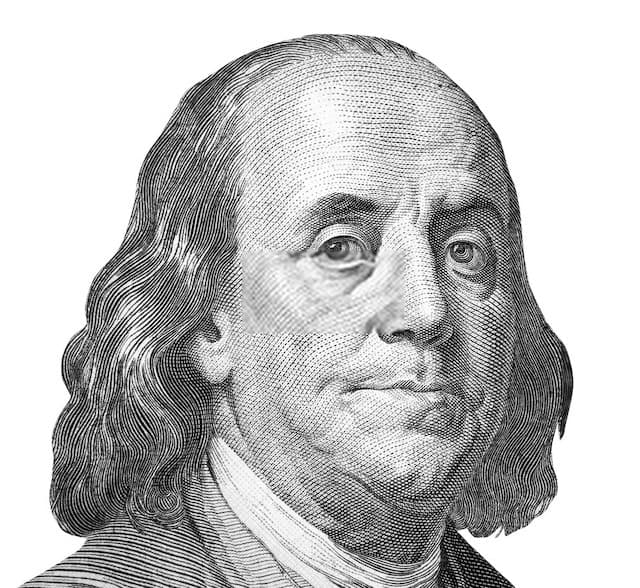
Following the new tax acts, public unrest was prominent in the colonies and Great Britain considered sending in more troops to protect its authorities. Benjamin Franklin, however, had predicted the Boston Massacre in 1768. At this time, Benjamin Franklin was in England as an ambassador, sent by the Royal Society. While still in England, he claimed that if the British sent more soldiers to America, They will not find a rebellion; they may indeed make one. Before leaving England, Franklin also predicted that a war between America and England was inevitable. He was unsure, however, if America could win.
Three African-Americans Testified on Behalf of the British Soldiers
The Boston Massacre is often recalled to commemorate Crispus Attucks’ representation of the role of African-Americans in the American Revolution. However, Boston Massacre facts show that there were three African-Americans who testified for the British soldiers. They were Andrew, Jack, and Newton Prince. Their testimony helped prevent the execution of the British soldiers. Newton Price, for example, testified in court that the crowd was striking on the soldiers’ guns with their sticks. He also testified that he heard no orders given to fire.
Boston Massacre Facts – Facts about the Boston Massacre Summary
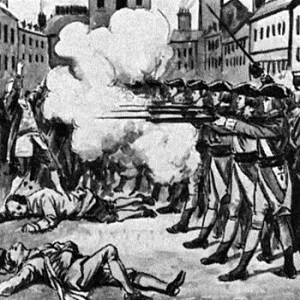 The Boston Massacre started simply as a street fight but later escalated into one of the most important events in the US history. The incident is considered the foundation of the American Revolution. There are many facts we can learn about the Boston Massacre. The incident caused the death of five people, including Crispus Attucks. John Adams defended the British soldiers and helped six of them get acquitted. Two British soldiers were convicted of manslaughter but escaped the death penalty. There is a monument to commemorate the event and a reenactment is held every year at the exact site.
The Boston Massacre started simply as a street fight but later escalated into one of the most important events in the US history. The incident is considered the foundation of the American Revolution. There are many facts we can learn about the Boston Massacre. The incident caused the death of five people, including Crispus Attucks. John Adams defended the British soldiers and helped six of them get acquitted. Two British soldiers were convicted of manslaughter but escaped the death penalty. There is a monument to commemorate the event and a reenactment is held every year at the exact site.
Was this page helpful?
Our commitment to delivering trustworthy and engaging content is at the heart of what we do. Each fact on our site is contributed by real users like you, bringing a wealth of diverse insights and information. To ensure the highest standards of accuracy and reliability, our dedicated editors meticulously review each submission. This process guarantees that the facts we share are not only fascinating but also credible. Trust in our commitment to quality and authenticity as you explore and learn with us.
